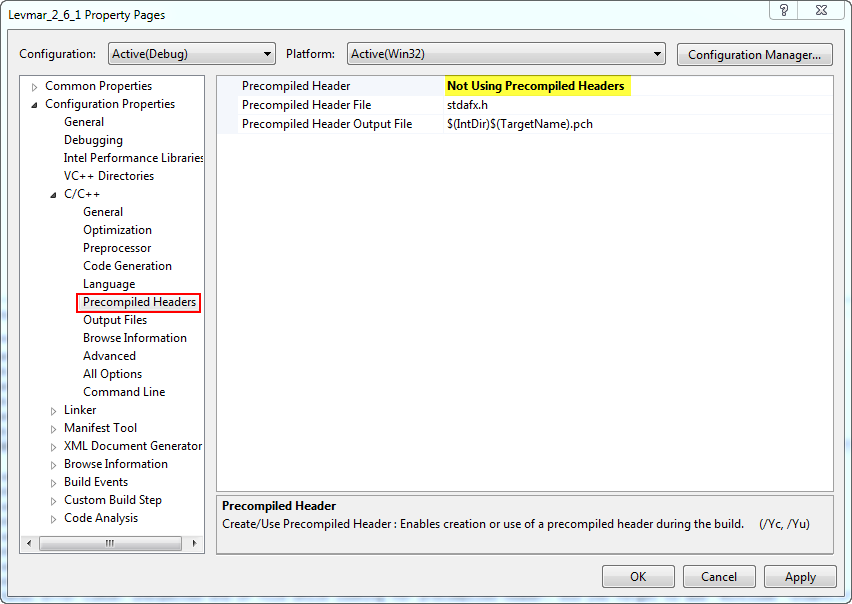Often, when calibrating financial models to market data, we need access to an optimization routine that minimizes the error between theoretical results and actual market results. This allows our model to "fit" the market data as best as possible. And often times the minimization function we are interested in is non-linear. In relatively small problems one can use Matlab's "lsqnonlin" or Python's "scipy.optimize.leastsq" built-in functions. They work quite well but they are slow. I came across this C++ implementation on the internet:
levmar. This is a very powerful routine built from the
Levenberg-Marquardt optimization algorithm. I was very keen to try this program but faced difficulties compiling it in Microsoft's Visual Studio. The package is very easily compiled in Unix systems where LAPACK is already included. I primarily work in the Windows environment however so I needed a way of building this solution in Visual Studio. In Visual Studio 2008, 2010, and 2012 I have successfully built the executable as follows:
First create a new Visual Studio project (File -> New -> Project).
Select the Win32 Console Application and give your project a name.
I removed the files (stdafx.h, stdafx.cpp, etc.) that came with the new project (I'm not sure if this is necessary or desirable). From the levmar files downloaded from the website I copied all of the C source and header files to my new project folder (excluding everything else):
C:\Users\Joel\Documents\Visual Studio 2012\Projects\Levmar_2_6_1\Levmar_2_6_1\
Once the files are in the project folder, from the Visual Studio Solution Explorer I right click on "Source Files" and select Add -> Existing Item. But we only add the C files that don't end in "_core".
From the README file:
Notice that *_core.c files are not to be compiled directly; For example,
Axb_core.c is included by Axb.c, to provide single and double precision
routine versions.
Similarly, we add the header files to the "Header Files" folder in the Solution Explorer.
Now, if you try to build this project, you will probably be greeted with the following error message:
fatal error C1010: unexpected end of file while looking for precompiled header. Did you forget to add '#include "stdafx.h"' to your source?
To get around this I selected the following:
If we try to build our project with this change we will see the following errors:
Build started: Project: Levmar_2_6_1, Configuration: Debug Win32 ------
1>Build started 19/07/2013 2:06:05 PM.
1>InitializeBuildStatus:
1> Touching "Debug\Levmar_2_6_1.unsuccessfulbuild".
1>ClCompile:
1> All outputs are up-to-date.
1> misc.c
1> lmlec.c
1> lmdemo.c
1> lmbleic.c
1> lmblec.c
1> lmbc.c
1> lm.c
1> Axb.c
1> Generating Code...
1>Axb.obj : error LNK2019: unresolved external symbol _dgeqrf_ referenced in function _dAx_eq_b_QR
1>Axb.obj : error LNK2019: unresolved external symbol _dorgqr_ referenced in function _dAx_eq_b_QR
1>lmlec.obj : error LNK2001: unresolved external symbol _dorgqr_
1>Axb.obj : error LNK2019: unresolved external symbol _dtrtrs_ referenced in function _dAx_eq_b_QR
1>Axb.obj : error LNK2019: unresolved external symbol _dpotrf_ referenced in function _dAx_eq_b_Chol
1>misc.obj : error LNK2019: unresolved external symbol _dgemm_ referenced in function _dlevmar_trans_mat_mat_mult
1>misc.obj : error LNK2019: unresolved external symbol _dpotf2_ referenced in function _dlevmar_chol
1>c:\users\joel\documents\visual studio 2012\Projects\Levmar_2_6_1\Debug\Levmar_2_6_1.exe : fatal error LNK1120: 30 unresolved externals
1>
1>Build FAILED.
1>
1>Time Elapsed 00:00:01.24
========== Build: 0 succeeded, 1 failed, 0 up-to-date, 0 skipped ==========
And the reason for this is that the build process cannot link to the LAPACK libraries (not included inWindows). Apparently there are ways to add this to Windows but I was unsuccessful in my endeavors. What I did instead was download a trial version of
Intel's "Composer XE 2013" program. Even though this program will expire after the trial period ends we're not actually interested in the program. Rather, we are interested in the library files that get installed (as far as I know, these do not expire). If you install this program in the default directory you will see this folder:
C:\Program Files (x86)\Intel\Composer XE 2013\mkl\lib\ia32
which contains the math kernel we are interested in. To link our Visual Studio project to these libraries, do the following:

and add the following dependency:
Now we will be able to successfully build our project. The resultant executable file will be found in your project's folder (either Debug or Release depending on what you have selected). From the command prompt, I can run the executable and see the following results:
Which are just the results of the selected optimization problem found in the lmdemo.c file. It worked!
Eventually I would like to modify this project to create a library that I can call from other programs. I may also try to create a DLL out of this that I can call from Python.







